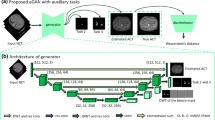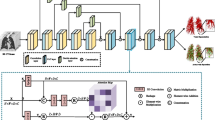Abstract
Purpose
Endobronchial intervention requires detailed modeling of pulmonary anatomical substructure, such as lung airway and artery-vein maps, which are commonly extracted from non-contrast computed tomography (NCCT) independently using automatic segmentation approaches. We aim to make the first attempt to jointly train a CNN-based model for airway and artery-vein segmentation along with synthetic contrast-enhanced CT (CECT) generation.
Methods
A multi-task framework is proposed to simultaneously generate three segmentation maps and synthesize CECTs. We first design a collaborative learning model with tissue knowledge interaction for lung airway and artery-vein segmentation. Meanwhile, a conditional adversarial training strategy is applied to generate CECTs from NCCTs guided by artery maps. Additionally, CECT identity and reconstruction help to regularize the model for plausible NCCT to CECT translation.
Results
Extensive experiments were conducted to evaluate the performance of the proposed framework based on three datasets (90 NCCTs for the airway task, 55 NCCTs for the artery-vein task and 100 CECTs for the artery task). The results demonstrate the effective improvement of our proposed method compared to other methods and configurations that can achieve more accurate segmentation maps (Dice score coefficients for these three tasks are: 93.6%, 80.7% and 82.4%, respectively) and realistic CECTs simultaneously. The ablation study further verifies the effectiveness of the components of the designed model.
Conclusion
This study demonstrates the model potential in multi-task learning that integrates anatomically relevant segmentation and performs NCCT to CECT translation. Such an interaction approach promotes mutually for both promising segmentation results and plausible synthesis.





Similar content being viewed by others
References
Gu Y, Gu C, Yang J, Sun J, Yang G-Z (2022) Vision-kinematics interaction for robotic-assisted bronchoscopy navigation. IEEE Trans Med Imaging 41(12):3600–3610
Shen M, Gu Y, Liu N, Yang G-Z (2019) Context-aware depth and pose estimation for bronchoscopic navigation. IEEE Robot Autom Lett 4(2):732–739
Fabijanska A (2009) Results of applying two-pass region growing algorithm for airway tree segmentation to MDCT chest scans from EXACT database. In: The 2nd international workshop on pulmonary image analysis, CreateSpace, USA, pp 251–260
Zhang M, Zhang H, Yang G-Z, Gu Y (2022) Cfda: Collaborative feature disentanglement and augmentation for pulmonary airway tree modeling of COVID-19 CTs. In: International conference on medical image computing and computer-assisted intervention, pp 506–516. Springer
Meng Q, Roth HR, Kitasaka T, Oda M, Ueno J, Mori K (2017) Tracking and segmentation of the airways in chest CT using a fully convolutional network. In: International conference on medical image computing and computer-assisted intervention, pp 198–207. Springer
Qin Y, Chen M, Zheng H, Gu Y, Shen M, Yang J, Huang X, Zhu Y-M, Yang G-Z (2019) Airwaynet: a voxel-connectivity aware approach for accurate airway segmentation using convolutional neural networks. In: International conference on medical image computing and computer-assisted intervention, pp 212–220. Springer
Garcia-Uceda Juarez A, Selvan R, Saghir, Z, Bruijne Md (2019) A joint 3d UNet-graph neural network-based method for airway segmentation from chest CTs. In: International workshop on machine learning in medical imaging, pp. 583–591. Springer
Charbonnier J-P, Brink M, Ciompi F, Scholten ET, Schaefer-Prokop CM, Van Rikxoort EM (2015) Automatic pulmonary artery-vein separation and classification in computed tomography using tree partitioning and peripheral vessel matching. IEEE Trans Med Imaging 35(3):882–892
Nardelli P, Jimenez-Carretero D, Bermejo-Pelaez D, Washko GR, Rahaghi FN, Ledesma-Carbayo MJ, Estépar RSJ (2018) Pulmonary artery-vein classification in CT images using deep learning. IEEE Trans Med Imaging 37(11):2428–2440
Pu J, Leader JK, Sechrist J, Beeche CA, Singh JP, Ocak IK, Risbano MG (2022) Automated identification of pulmonary arteries and veins depicted in non-contrast chest CT scans. Med Image Anal 77:102367
Qin Y, Zheng H, Gu Y, Huang X, Yang J, Wang L, Yao F, Zhu Y-M, Yang G-Z (2021) Learning tubule-sensitive CNNs for pulmonary airway and artery-vein segmentation in CT. IEEE Trans Med Imaging 40(6):1603–1617
Payer C, Pienn M, Bálint Z, Shekhovtsov A, Talakic E, Nagy E, Olschewski A, Olschewski H, Urschler M (2016) Automated integer programming based separation of arteries and veins from thoracic CT images. Med. Image Anal 34:109–122
Namasivayam S, Kalra MK, Torres WE, Small WC (2006) Adverse reactions to intravenous iodinated contrast media: a primer for radiologists. Emerg Radiol 12:210–215
Goodfellow I, Pouget-Abadie J, Mirza M, Xu B, Warde-Farley D, Ozair S, Courville A, Bengio Y (2020) Generative adversarial networks. Commun ACM 63(11):139–144
Armato SG III, McLennan G, Bidaut L, McNitt-Gray MF, Meyer CR, Reeves AP, Zhao B, Aberle DR, Henschke CI, Hoffman EA (2011) The lung image database consortium (LIDC) and image database resource initiative (IDRI): a completed reference database of lung nodules on CT scans. Med. Phys 38(2):915–931
Lo P, Van Ginneken B, Reinhardt JM, Yavarna T, De Jong PA, Irving B, Fetita C, Ortner M, Pinho R, Sijbers J (2012) Extraction of airways from CT (EXACT’09). IEEE Trans Med Imaging 31(11):2093–2107
Yushkevich PA, Piven J, Hazlett HC, Smith RG, Ho S, Gee JC, Gerig G (2006) User-guided 3d active contour segmentation of anatomical structures: significantly improved efficiency and reliability. Neuroimage 31(3):1116–1128
Wang K, Qiu Z, Wang W, Song T, Cao S, Zhao Y, Liu J, He Y, Gan S, Liang X, Xu M, Guo Z (2022) Pulmonary artery segmentation challenge 2022. Zenodo. https://doi.org/10.5281/zenodo.6361906
Zhang H, Li J, Shen M, Wang Y, Yang G-Z (2019) Ddu-nets: distributed dense model for 3d MRI brain tumor segmentation. In: International MICCAI Brainlesion workshop, pp 208–217. Springer
Zhang H, Shen M, Shah PL, Yang G-Z (2020) Pathological airway segmentation with cascaded neural networks for bronchoscopic navigation. In: 2020 IEEE international conference on robotics and automation (ICRA), pp 9974–9980. IEEE
Ronneberger O, Fischer P, Brox T (2015) U-net: convolutional networks for biomedical image segmentation. In: International conference on medical image computing and computer-assisted intervention, pp 234–241. Springer
Isensee F, Jaeger PF, Kohl SA, Petersen J, Maier-Hein KH (2021) nnU-Net: a self-configuring method for deep learning-based biomedical image segmentation. Nature Methods 18(2):203–211
Wu Y, He K (2018) Group normalization. In: Proceedings of the European conference on computer vision (ECCV), pp 3–19
Ioffe S, Szegedy C (2015) Batch normalization: Accelerating deep network training by reducing internal covariate shift. In: International conference on machine learning, pp. 448–456. PMLR
He K, Zhang X, Ren S, Sun J (2015) Delving deep into rectifiers: surpassing human-level performance on imagenet classification. In: Proceedings of the IEEE international conference on computer vision, pp 1026–1034
Acknowledgements
This work was partly supported by Shanghai Sailing Program (20YF1420800) and National Nature Science Foundation of China (No. 62003208).
Author information
Authors and Affiliations
Corresponding authors
Ethics declarations
Conflict of interest
The authors declare that they have no conflict of interest.
Ethical approval
This article does not contain any studies with human participants or animals performed by any of the authors.
Informed consent
The study conducted experiments based on two publicly available datasets. The access of our airway dataset should be applied for research purposes upon reasonable request.
Additional information
Publisher's Note
Springer Nature remains neutral with regard to jurisdictional claims in published maps and institutional affiliations.
Rights and permissions
Springer Nature or its licensor (e.g. a society or other partner) holds exclusive rights to this article under a publishing agreement with the author(s) or other rightsholder(s); author self-archiving of the accepted manuscript version of this article is solely governed by the terms of such publishing agreement and applicable law.
About this article
Cite this article
Zhang, H., Zhang, M., Gu, Y. et al. Deep anatomy learning for lung airway and artery-vein modeling with contrast-enhanced CT synthesis. Int J CARS 18, 1287–1294 (2023). https://doi.org/10.1007/s11548-023-02946-7
Received:
Accepted:
Published:
Issue Date:
DOI: https://doi.org/10.1007/s11548-023-02946-7




